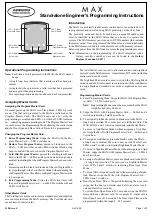Analog-to-Digital Converter (ADC12)
MCF51CN128 Reference Manual, Rev. 6
15-12
Freescale Semiconductor
When the conversion is completed, the result is placed in the data registers (ADCRH and ADCRL). In
10-bit mode, the result is rounded to 10 bits and placed in the data registers (ADCRH and ADCRL). In
8-bit mode, the result is rounded to 8 bits and placed in ADCRL. The conversion complete flag (COCO)
is then set and an interrupt is generated if the conversion complete interrupt has been enabled (AIEN = 1).
The ADC module has the capability of automatically comparing the result of a conversion with the
contents of its compare registers. The compare function is enabled by setting the ACFE bit and operates
with any of the conversion modes and configurations.
15.4.1
Clock Select and Divide Control
One of four clock sources can be selected as the clock source for the ADC module. This clock source is
then divided by a configurable value to generate the input clock to the converter (ADCK). The clock is
selected from one of the following sources by means of the ADICLK bits.
•
The bus clock. This is the default selection following reset.
•
The bus clock divided by two. For higher bus clock rates, this allows a maximum divide by 16 of
the bus clock.
•
ALTCLK, as defined for this MCU (See module section introduction).
•
The asynchronous clock (ADACK). This clock is generated from a clock source within the ADC
module. When selected as the clock source, this clock remains active while the MCU is in wait or
stop3 mode and allows conversions in these modes for lower noise operation.
Whichever clock is selected, its frequency must fall within the specified frequency range for ADCK. If the
available clocks are too slow, the ADC do not perform according to specifications. If the available clocks
are too fast, the clock must be divided to the appropriate frequency. This divider is specified by the ADIV
bits and can be divide-by 1, 2, 4, or 8.
15.4.2
Input Select and Pin Control
The pin control registers disable the I/O port control of the pins used as analog inputs.When a pin control
register bit is set, the following conditions are forced for the associated MCU pin:
•
The output buffer is forced to its high impedance state.
•
The input buffer is disabled. A read of the I/O port returns a zero for any pin with its input buffer
disabled.
•
The pullup is disabled.
15.4.3
Hardware Trigger
The ADC module has a selectable asynchronous hardware conversion trigger, ADHWT, enabled when the
ADTRG bit is set. This source is not available on all MCUs. Consult the module introduction for
information on the ADHWT source specific to this MCU.
When ADHWT source is available and hardware trigger is enabled (ADTRG=1), a conversion is initiated
on the rising edge of ADHWT. If a conversion is in progress when a rising edge occurs, the rising edge is
ignored. In continuous convert configuration, only the initial rising edge to launch continuous conversions

















